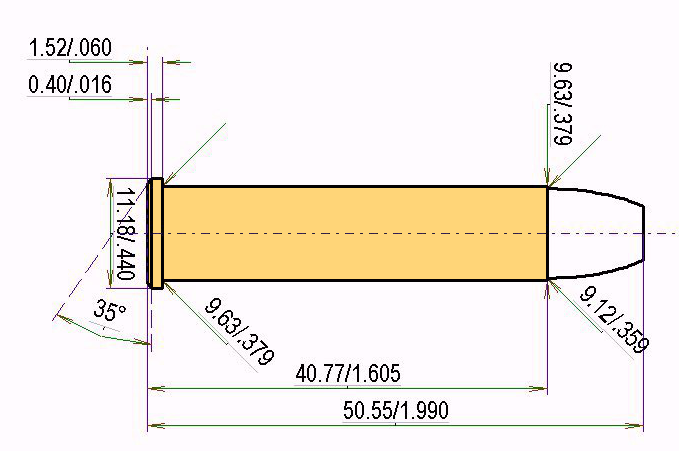Caliber Description
The .357 Maximum, also known as the .357 Remington Maximum, has an intriguing history that appeals to ammunition reloaders and firearms enthusiasts alike. Introduced in the early 1980s through a collaboration between Remington Arms and Ruger, this revolver cartridge was developed as an extended version of the popular .357 Magnum. The idea was to create a round that produced higher velocity and greater energy for silhouette shooting and hunting. Measuring approximately 1.605 inches in case length, the .357 Maximum offered significant performance improvements over its predecessor. Despite initial enthusiasm, the cartridge’s popularity waned after issues with flame cutting on revolver top straps emerged, especially in Ruger’s Blackhawk revolvers, limiting its adoption. However, its legacy persists among reloaders who value its unique combination of power and versatility.
In practical applications, the .357 Maximum excels in niche roles, particularly handgun metallic silhouette shooting and field hunting. Its high velocity and flat trajectory make it ideal for knocking down heavy steel targets at extended ranges, which explains its continued use in silhouette competitions. The cartridge’s impressive performance has also attracted handgun hunters seeking a robust round for medium to large game. The extra powder capacity allows reloaders to tailor loads for hunting deer, hogs, and even coyotes, making the .357 Maximum a versatile option in the field. Although revolver offerings have diminished over the years, the cartridge found renewed life in custom single-shot pistols and Thompson/Center Contender barrels, where flame cutting is not a concern. For reloaders, the .357 Maximum offers a rewarding challenge, providing a platform for experimenting with a wide range of loads and projectiles.
When it comes to target species, the .357 Maximum is most commonly used for hunting mid-sized game animals such as whitetail deer and wild hogs. With appropriate bullets and careful load selection, ethical kills are possible out to 100 yards or more, especially with precision handloads. Coyote and other varmints are also within reach, especially with lighter, faster projectiles. For metallic silhouette shooters, the .357 Maximum’s power ensures reliable knockdown of stubborn rams and turkeys at distance. Reloaders appreciate the cartridge for its ability to be adapted to a variety of hunting and shooting scenarios, particularly when paired with the right bullet for the intended species and range.
Bullet weights for the .357 Maximum typically range from 158 grains to 200 grains, although some reloaders experiment with even heavier cast lead projectiles or jacketed bullets for specific purposes. Lighter 158-grain bullets often deliver flatter trajectories and higher velocities, ideal for varminting or competition, while 180- to 200-grain projectiles provide the deep penetration desirable for hunting larger game. Handloaders can exploit the large case capacity to tailor their loads for specific firearms and tasks, using powders like H110, 4227, or AA1680 to achieve the desired performance. As with any high-performance magnum, attention to proper crimping and primer selection is essential for consistent ignition and safe operation. The .357 Maximum’s characteristics make it a compelling choice for reloaders who enjoy experimenting with cartridge performance and exploring the upper limits of handgun ballistics.
Popular Load Recipes
- 180 gr JHP, 20.0 gr H110, CCI 400 primer, OAL 1.995"
- 158 gr JSP, 21.0 gr IMR4227, Federal 205 primer, OAL 1.960"
- 158 gr JHP, 17.5 gr 2400, CCI 400 primer, OAL 1.950"
- 200 gr RNFP, 17.0 gr IMR4227, Winchester SR primer, OAL 2.020"
- 180 gr XTP, 20.5 gr AA1680, CCI 400 primer, OAL 2.000"
- 158 gr SWC, 15.0 gr 2400, Winchester SR primer, OAL 1.950"
- 180 gr JSP, 22.0 gr H4227, CCI 400 primer, OAL 2.000"
- 210 gr SWC, 15.0 gr N110, Federal 205 primer, OAL 2.030"
*Always start 10% below max load and work up, consult official reloading manuals, verify all data for your firearm and components*
Cost per Reloaded Round
Factory-loaded .357 Maximum ammunition is scarce and expensive, often costing about $60–$80 per box of 20 rounds (using higher estimate, $4.00 per round).
Reloading requires:
- Primers: ~$0.07 each
- Powder: for a full-power load, about 20 grains (1 pound = 7000 grains; 1 lb of powder at $40 yields 350 rounds; per round cost ~$0.11)
- Bullets: lead or jacketed, typically $0.20–$0.30 each (let’s use $0.25)
- Cases: normally reusable, initial investment split over many uses; per-load cost negligible for this comparison
Total reload cost per round:
$0.07 (primer) + $0.11 (powder) + $0.25 (bullet) = $0.43
Factory ammo: $4.00 per round
Reloading: $0.43 per round
Savings per round: $4.00 – $0.43 = $3.57
If you shoot a box of 20 rounds:
Savings per box = 20 * $3.57 = $71.40
So, you save approximately $3.57 per round by reloading .357 Maximum instead of buying factory ammunition.
Technical Specifications
Safety Standard / Application
C.I.P. / Revolver / Pistol Caliber
Most Suitable Bullet Weights
102 - 190 Grains
Case Capacity / Average Charge
33.6 Grains of Water / 13.3 Grains
Average Muzzle Velocity / Energy
1493 fps / 653 ft-lbf
Case Length / Max. C.O.L
1.6'' / 1.99''
